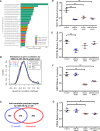Integrative genetic and genomic networks identify microRNA associated with COPD and ILD
- PMID: 37567908
- PMCID: PMC10421936
- DOI: 10.1038/s41598-023-39751-w
Integrative genetic and genomic networks identify microRNA associated with COPD and ILD
Abstract
Chronic obstructive pulmonary disease (COPD) and interstitial lung disease (ILD) are clinically and molecularly heterogeneous diseases. We utilized clustering and integrative network analyses to elucidate roles for microRNAs (miRNAs) and miRNA isoforms (isomiRs) in COPD and ILD pathogenesis. Short RNA sequencing was performed on 351 lung tissue samples of COPD (n = 145), ILD (n = 144) and controls (n = 64). Five distinct subclusters of samples were identified including 1 COPD-predominant cluster and 2 ILD-predominant clusters which associated with different clinical measurements of disease severity. Utilizing 262 samples with gene expression and SNP microarrays, we built disease-specific genetic and expression networks to predict key miRNA regulators of gene expression. Members of miR-449/34 family, known to promote airway differentiation by repressing the Notch pathway, were among the top connected miRNAs in both COPD and ILD networks. Genes associated with miR-449/34 members in the disease networks were enriched among genes that increase in expression with airway differentiation at an air-liquid interface. A highly expressed isomiR containing a novel seed sequence was identified at the miR-34c-5p locus. 47% of the anticorrelated predicted targets for this isomiR were distinct from the canonical seed sequence for miR-34c-5p. Overexpression of the canonical miR-34c-5p and the miR-34c-5p isomiR with an alternative seed sequence down-regulated NOTCH1 and NOTCH4. However, only overexpression of the isomiR down-regulated genes involved in Ras signaling such as CRKL and GRB2. Overall, these findings elucidate molecular heterogeneity inherent across COPD and ILD patients and further suggest roles for miR-34c in regulating disease-associated gene-expression.
© 2023. Springer Nature Limited.
Conflict of interest statement
The authors declare no competing interests.
Figures





References
-
- Osei ET, et al. Unravelling the complexity of COPD by microRNAs: It’s a small world after all. Eur. Respir. J. 2015;46:807–818. - PubMed
-
- Raherison C, Girodet P-O. Epidemiology of COPD. Eur. Respir. Rev. 2009;18:213–221. - PubMed
-
- Skolnik K, Ryerson CJ. Unclassifiable interstitial lung disease: A review. Respirology. 2016;21:51–56. - PubMed
Publication types
MeSH terms
Substances
Grants and funding
LinkOut - more resources
Full Text Sources
Molecular Biology Databases
Research Materials
Miscellaneous

